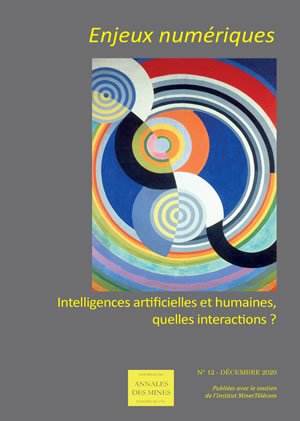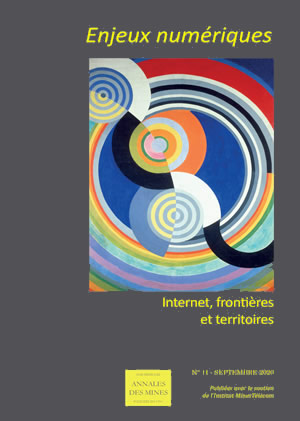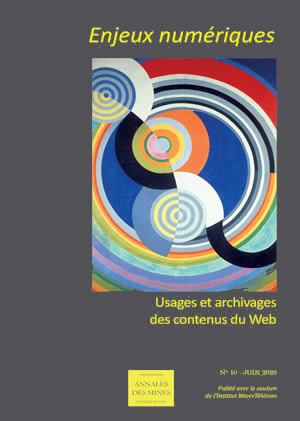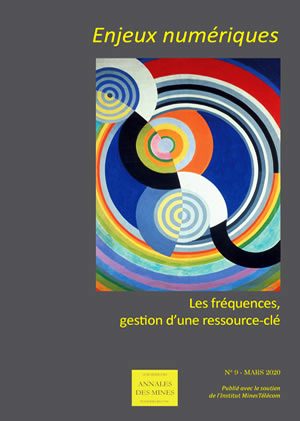| |
 
Digital Issues is a quarterly series (March, June, September and December) freely downloadable on www.annales.org, with a print version in French language.Focus of the series is on the issues of the digital transition for an enlightened, yet non necessarily expert, readership. Various viewpoints are being used between technology, economy and society as the Annales des Mines are used to doing in all their series.
 See membership of Editorial board See membership of Editorial board
|
 
|
| |
|
|
|
| |

Voir le numéro complet
|
|
 N° 12 - December N° 12 - December
Artificial and human intelligences: What interactions?
issue editor: Arnaud de LA FORTELLE
 read summary and abstracts read summary and abstracts
Introduction :
Arnaud de LA FORTELLE
PSL – MINES ParisTech
Artificial intelligence (AI) is fascinating: the human mind ramped up by computers! The consequences are fantastic both operationally and socially, to such a point that the development of forms of AI has sparked warnings from Stephen Hawking and Bill Gates about the possible end of humanity. Many others have called for vigilance. We need but read the list of signatories of the Future of Life Institute’s open letter. These persons are not technophobes or ignoramuses. So, where are we headed?
As a starter, what is AI? A conventional response compares AI to human activities, usually for the purpose of distinguishing between the two (the Turing test) or even making them compete, and sometimes (for transhumanists) detecting the point when human beings will be fully supplanted. These presentations are effective and attractive but ultimately very prospective, about a faraway future. Although the rollout of AI algorithms is having impressive consequences, reality does not resemble works of fiction.
 read more read more
|
|
| |
|
|
| |

Voir le numéro complet
|
|
 N° 11 - September N° 11 - September
Internet, Borders and Territories
issue editor : Pierre BONIS
 read summary and abstracts read summary and abstracts
Introduction:
Pierre BONIS
Directeur général de l’AFNIC
Every day, more than 4.5 billion human beings are “connected” — needless to say to what! As everyone knows, this can only be to the Internet.
On this network of computer networks which, for more than thirty years now, has grown along with the globalization of exchanges on all continents, users exchange sounds, videos, texts. All, or nearly all, communication techniques that have marked human progress since the invention of the printing press are found on this technological system. On the Internet, we publish, telephone, watch or even make films, keep informed…. We do not yet move, but there is talk about e-presence, e-medicine and even holographic communications. No form of communication, exchange or action fully bypasses the Internet — if it tends to do so, plans are being made to eventually put it “on the Internet”.
In the beginning, the Internet was the call of the open sea beckoning the general public with a virtual fading of distance and differences, a call to explore this terra incognita. From the memory of anyone who lived through this pristine period, one of the best examples is the first invoices received for a subscription to an Internet service-provider in the late 1990s. We were browsing American sites, participating on British forums, accessing contents hosted by Japanese universities; but France Télécom still always billed a local communication — a world within reach of our fingertips via a local connection!
 read more read more
|
|
| |
|
|
| |

Voir le numéro complet
|
|
 N° 10 - June 2020 N° 10 - June 2020
Web contents: Uses and archives
issue editor : Michel SCHMITT
 read summary and abstracts read summary and abstracts
Introduction:
Michel SCHMITT
Conseil général de l’Economie (CGE)
Once upon a time, there were floppy disks with a capacity of 128 kilobytes…. This puts a smile on the face of the older among us, since the Internet and cloud have blown away such objects while imbuing us with the sensation that the space for storing contents is sky high… after all, the contents at our disposal are infinite. Websites offer libraries of films, music and books, all in an astonishing quantity.
This profusion of resources on the Web has changed our behavior patterns. Looking for information or a definition? Wikipedia on the smartphone, which is within reach if not already in our hands. The answer is instantaneous, whereas going to a library or looking for your favorite dictionary and thumbing through it takes much more time. Besides, since the dictionary is an edition dating back a few years, its information might be outdated and, to clap the climax, the information found has not been indexed. As this anecdote shows, the quantity and immediacy of the information placed on the Net have changed our relation to knowledge and spawned new uses.
 read more read more
|
|
| |
|
|
| |

Voir le numéro complet
|
|
 N° 9 - March 2020 N° 9 - March 2020
The radio-frequency spectrum! Management of a key resource
issue editor : François RANCY
 read summary and abstracts read summary and abstracts
Foreword:
Gilles BRÉGANT
general manager of the Agence Nationale des Fréquences (ANFR)
Though invisible, radio frequencies have stage-managed for what is happening in much of the visible world. Our everyday lives are now “wireless”. Remote controls, mobile telephones, satellites, radar, etc. are weaving imperceptible webs that endow us with powers like those that heroes or the gods used to wield: actions at a distance, ubiquity, foreknowledge of the weather, sight in the dark, unlimited and instantaneous access to knowledge, etc.
Within a few decades, humanity has discovered and learned to control the radio-frequency spectrum, this strange natural resource. Just as the discovery of the New World upturned history after the 15th century, we shall probably come to realize that the exploration of this terra incognita measured in hertz instead of hectares has set the stage for our destinies since the start of the 20th century. Wireless transmission, radio stations, radar, live broadcasts worldwide, satellites, GPS and mobile telephones have, over the past century, set a fast pace for a humanity that is amazed or… bewildered. As engineers domesticate new bandwidths with esoteric names tainted with mystery (the Ku, Ka and X bands), this resource, though scarce, has new, endless prospects. The speed at which changes have followed upon each other inevitably arouses apprehension. Some persons suspect that the wizardry of radio frequencies is a black magic. However this technology has never been so well controlled as it now is at the start of the 21st century.
 read more read more
Introduction:
François RANCY
director of the ITU-R’s Radiocommunication Bureau
The radio-frequency spectrum is a scarce resource used by most of the applications on which our societies have, within a few decades, become so dependent, ranging from GSM to 5G, from Wi-Fi to Bluetooth, from GPS to satellite imagery, from FM radio to DAB, DDTV and television by satellite. Many an essential activity relies on this spectrum — transportation by air, river and sea, defense and security systems, scientific and spatial research, meteorology, monitoring of the climate and Earth’s resources….
Five billion people currently subscribe to at least one mobile service, including three billion for wideband. Thanks to six billion receivers of radio navigation by satellite, we can be located at all times and at any point on the globe. Nearly two billion people have digital terrestrial television (DTTV); and more than a billion, a receiver for television via satellite. All of this uses frequency bands that have been harmonized, organized and protected worldwide for decades now, while the underlying technology has been undergoing development.
 read more read more
|
|
| |
|
|
| |
|
|
|






